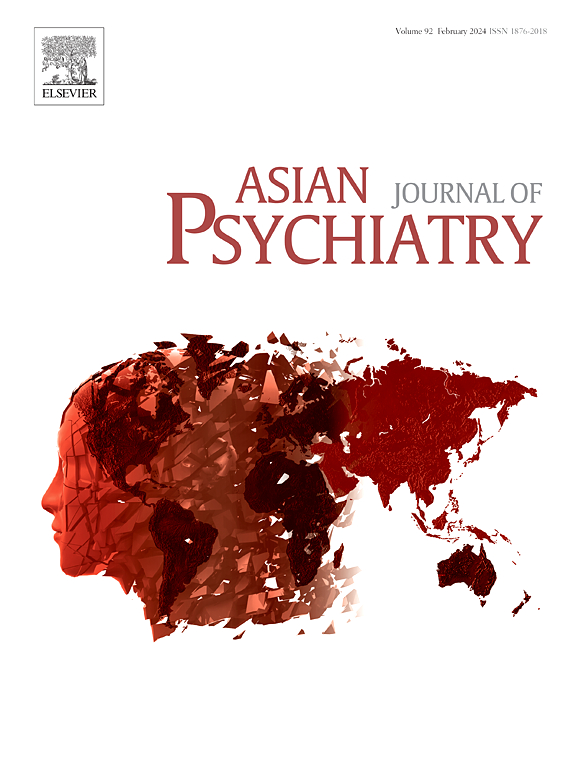Retinal macular morphology and cognitive functions in unmedicated first-episode psychosis patients
IF 4.5
4区 医学
Q1 PSYCHIATRY
引用次数: 0
Abstract
Background
This study investigates retinal macular abnormalities and neurocognitive function, including facial emotion recognition, in individuals with unmedicated First-Episode Psychosis (FEP). The primary aim is to compare retinal morphology in FEP patients and healthy controls and examine correlations with cognitive performance.
Method
Thirty-two FEP patients (aged 18–45) and 30 healthy controls underwent psychiatric assessment and retinal examination using the Spectral Domain - Optical Coherence Tomography (SD-OCT), with a focus on macula. Facial emotion recognition was evaluated using the Mandal emotion recognition test for four emotions (Sad, Anger, Happy, Fear). Visual memory and executive function were assessed using the Rey-Osterrieth Complex Figure Test and the Trail Making Test, respectively. Statistical analyses included t-test, correlation analysis, and linear discriminant function analysis.
Results
FEP patients showed significant macular abnormalities, with reduced thickness in multiple quadrants. Facial emotion recognition scores were notably lower among patients for all emotions tested. Patients also showed visual memory deficits. Across the three measures there were significant correlations. Discriminant function analysis indicated that a combination of emotion recognition scores and inner nasal quadrant macular thickness of left eye could effectively differentiate patients from healthy controls with high accuracy (85.5 %).
Conclusion
Our study demonstrates significant macular abnormalities, impaired facial emotion recognition, and visual memory deficits in patients with unmedicated FEP. These findings suggest potential of retinal abnormalities as biomarkers for psychosis. Future research with larger sample sizes could further establish retinal changes and facial emotion recognition as potential biomarkers.
未服药首发精神病患者的视网膜黄斑形态和认知功能
本研究调查了未服药的首发精神病(FEP)患者的视网膜黄斑异常和神经认知功能,包括面部情绪识别。主要目的是比较FEP患者和健康对照的视网膜形态,并检查其与认知表现的相关性。方法采用光谱域光学相干断层扫描(SD-OCT)对32例18-45岁的FEP患者和30名健康对照者进行精神评估和视网膜检查,重点检查黄斑。使用Mandal情绪识别测试对四种情绪(悲伤、愤怒、快乐、恐惧)进行面部情绪识别评估。视觉记忆和执行功能分别采用Rey-Osterrieth复杂图形测验和Trail Making Test进行评估。统计分析包括t检验、相关分析和线性判别函数分析。结果fep患者黄斑异常明显,多象限厚度降低。在所有情绪测试中,患者的面部情绪识别得分都明显较低。患者还表现出视觉记忆缺陷。三种测量方法之间存在显著的相关性。判别函数分析表明,情绪识别评分与左眼内鼻象限黄斑厚度相结合能有效区分患者与健康对照,准确率高达85.5 %。结论:我们的研究表明,非药物FEP患者存在明显的黄斑异常、面部情绪识别受损和视觉记忆缺陷。这些发现提示视网膜异常可能是精神病的生物标志物。未来更大样本量的研究可以进一步确定视网膜变化和面部情绪识别作为潜在的生物标志物。
本文章由计算机程序翻译,如有差异,请以英文原文为准。
求助全文
约1分钟内获得全文
求助全文
来源期刊

Asian journal of psychiatry
Medicine-Psychiatry and Mental Health
CiteScore
12.70
自引率
5.30%
发文量
297
审稿时长
35 days
期刊介绍:
The Asian Journal of Psychiatry serves as a comprehensive resource for psychiatrists, mental health clinicians, neurologists, physicians, mental health students, and policymakers. Its goal is to facilitate the exchange of research findings and clinical practices between Asia and the global community. The journal focuses on psychiatric research relevant to Asia, covering preclinical, clinical, service system, and policy development topics. It also highlights the socio-cultural diversity of the region in relation to mental health.
 求助内容:
求助内容: 应助结果提醒方式:
应助结果提醒方式:


